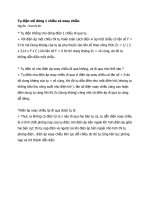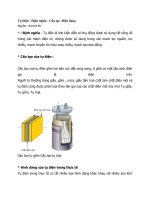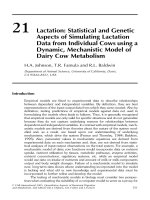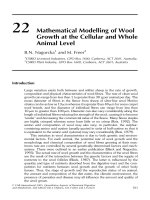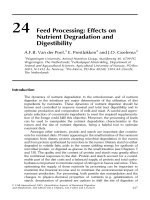Tài liệu Tự điển Food Science, Technology And Nutrition - Vần I,J pdf
Bạn đang xem bản rút gọn của tài liệu. Xem và tải ngay bản đầy đủ của tài liệu tại đây (155.83 KB, 14 trang )
adults, often with fatal results. Also used in connection with
deliberate reduction of body temperature to 28°C to permit
heart and brain surgery.
hypothyroidism Underactivity of the thyroid gland, leading to
reduced secretion of thyroid hormones and a reduction in basal
metabolic rate. Commonly associated with goitre due to iodine
deficiency. In hypothyroid adults there is a characteristic moon-
faced appearance, lethargy and dull mental apathy. In infants,
hypothyroidism can lead to severe mental retardation, cretinism.
See also thyrotoxicosis.
hypotonic A solution more dilute than the body fluids, See
isotonic.
hypovitaminosis vitamin deficiency.
hypoxanthine A purine, an intermediate in the metabolism of
adenine and guanine to uric acid.
hyssop Pungent aromatic herb, Hyssopus officinalis, used in
salads, soups and in making liqueurs.
I
iatrogenic A condition caused by medical intervention or drug
treatment; iatrogenic nutrient deficiency is caused by drug–
nutrient interactions.
IBC Intermediate bulk container.
iberian moss See carrageenan.
ice cream A frozen confection made from fat, milk solids and
sugar. Some European countries permit the use of non-milk fat
and term the product ice cream, while if milk fat is used, it is
termed dairy ice cream. According to UK regulations, contains
not less than 5% fat and 7% other milk solids. In the USA the
minimum butterfat content is 10% with at least 20% total milk
solids. Reduced fat ice cream contains 25% less fat, and light ice
cream 50% less fat, or one-third less energy (and less than 50%
of energy from fat). Low-fat ice cream contains not more than
3g, and non-fat ice cream less than 0.5g milk fat per serving.
Stabilisers such as carboxymethylcellulose, gums and alginates
are included, and emulsifiers such as polysorbate and monoglyc-
erides. Mono- and diglycerides bind the looser globules of water
and are added in ‘non-drip’ ice cream.
ice, eutectic See eutectic ice.
Iceland moss A lichen, Cetraria islandica, that can be boiled to
make a jelly.
ichthyosarcotoxins Toxins in fish.
IDDM Insulin-dependent diabetes mellitus.
249
idi Indian, Sri Lankan; steamed bread made from rice and legume
flour. The dough is left to undergo bacterial fermentation
overnight; the main organisms are Leuconostoc mesenteroides
and Streptococcus faecalis.
idiopathic A condition of unknown origin or cause.
idiosyncrasy Unusual and unexpected sensitivity or reaction to a
drug or food.
IDL Intermediate-density lipoprotein; see lipoproteins, plasma.
idli S.E. Asian; small cakes made from a mixture of cooked rice
and black gram, fermented with the aid of mould.
IHD Ischaemic heart disease.
ileitis Inflammation of the ileum.
ileocolitis Inflammation of the ileum and colon.
ileostomy Surgical formation of an opening of the ileum on the
abdominal wall, performed to treat severe ulcerative colitis; see
gastrointestinal tract.
ileotomy Surgical removal of (part of) the ileum.
ileum Last portion of the small intestine, between the jejunum
and the colon (large intestine), see gastrointestinal tract.
ileus Obstruction of the intestines, see gastrointestinal tract.
illipe butter See cocoa butter equivalents.
IMF See intermediate moisture foods.
immune system Series of defence mechanisms of the body. There
are two major parts: humoral, mediated through antibodies
secreted into the circulation (immunoglobulins); and cell-
mediated. Lymphocytes produce antibodies against, and bind to,
the antigens of foreign cells, leading to death of the invading
organisms; other white blood cells are phagocytic and engulf the
invading organisms.
immunoassay A variety of analytical techniques with very high
specificity and sensitivity using antibodies raised against the
analyte, coupled with an enzyme, fluorescent dye or radioactive
material as a detection system.
See also elisa; fluorescence immunoassay; radioimmunoas-
say.
immunoglobulins Specific antibodies produced in the blood in
response to foreign proteins or other antigens.Five classes, IgA,
IgE, IgG, IgM and IgI; present in circulating blood as a result of
previous exposure to the antigens, and also present in breast milk
to confer passive immunity.
immunomagnetic separation Technique for rapid isolation of
food-borne pathogens using magnetic microspheres coated with
antibodies.
IMP (1) See integrating motor pneumotachograph.
(2) Inosine monophosphate, one of the purine nucleotides.
250
impingement drying Hot air is blown against the surface of the
food through nozzles; used mainly to remove surface moisture
from thin sheets of food.
improvers, flour See ageing.
IMS See immunomagnetic separation.
inanition Exhaustion and wasting due to complete lack or non-
assimilation of food; a state of starvation.
inborn errors of metabolism See genetic disease.
incaparina A number of protein-rich dietary supplements devel-
oped by the Institute of Nutrition of Central America and Panama
(INCAP),based on cottonseed flour,or soya and vegetables, with
various nutrient supplements,containing 27.5% protein.
incidence rate Measure of morbidity based on the number of new
episodes of a disease arising in a population over a given period
of time.
See also prevalence rate.
incretins Hormones that increase the amount of insulin secreted
in response to glucose, reduce glucagon secretion and delay
gastric emptying. They may also have actions to improve insulin
sensitivity, and they may increase the formation of pancreatic
β-islet cells.
See also gip; glp-1; orexins.
index of nutritional quality (INQ) An attempt to provide an
overall figure for the nutrient content of a food or diet.The ratio
of the amount of the nutrient/1000kcal:the reference intake/
1000kcal.
Indian corn See maize.
Indian fig See prickly pear.
Indian gum Ghatti gum, polysaccharide exudate from the stems
of Anogeissus latifolia.
Indian rice grass Perennial, growing wild in the USA, Oryzopsis
hymenoides; tolerant to drought. The seeds resemble millet,
small, round, dark in colour, covered with white hairs. Tradition-
ally used by native Americans for flour, now almost exclusively
for forage.
indigestion Discomfort and distension of the stomach after a
meal, also known as dyspepsia, including heartburn. Persistent
indigestion may be a symptom of a digestive disorder such as
hiatus hernia or peptic ulcer.
indigo carmine Blue food colour (E-132), derivative of indigotin,
which comes from tropical leguminous plants Indigofera spp.
induction Of enzymes; an increase in the total amount of the
enzyme protein in a cell as a result of increased transcription
of DNA, leading to an increased amount of mRNA.
See also repression.
251
induction period The lag period during which a fat or oil shows
stability to oxidation because of its content of natural or added
antioxidants, which are oxidised preferentially. After this there
is a sudden and large consumption of oxygen and the fat
becomes rancid.
infarction Death of an area of tissue because its blood supply has
been stopped.
INFOODS International Network of Food Data Systems, created
to develop standards and guidelines for collection of food com-
position data, and standardised terminology and nomenclature.
Web site />infuse (infusion) To extract the flavour from herbs, spices, etc., by
steeping them in a liquid, usually by pouring on boiling liquid,
covering and leaving to stand without further cooking, as in
making tea.
injera Ethiopean; flat bread made from teff flour fermented
for 30–72 hours with a starter from a previous batch; the main
organism is the yeast Candida guilliermondii.
inorganic Materials of mineral, as distinct from animal or veg-
etable, origin. Apart from carbonates and cyanides, inorganic
chemicals are those that contain no carbon.
inositol A carbohydrate derivative which is an essential nutrient
for micro-organisms and many animals and sometimes classified
as a vitamin, although there is no evidence that it is a dietary
essential for human beings. Deficiency causes alopecia in
mice and ‘spectacle eye’ (denudation around the eye) in rats.
Obsolete names inosite and meat sugar.
Chemically, hexahydrocyclohexane (CHOH)
6
; there are nine
isomers, but only one, meso- or myo-inositol, is of physiological
importance. It is a constituent of many phospholipids (phos-
phatidyl inositols) involved in membrane structure and as part
of the signalling mechanism for hormones which act at the cell
surface. The insecticide gammexane is hexachlorocyclohexane,
and appears to function by competing with inositol. Inositol
hexaphosphate is phytic acid.
INQ See index of nutritional quality.
in silico Experiments conducted by computer simulation, by
analogy with IN VITRO and IN VIVO.
instant foods Dried foods that reconstitute rapidly when water is
added, e.g. tea, coffee, milk, soups, precooked cereal products,
potatoes. The dried powders may be agglomerated to control
particle size and improve solubility. ‘Instant puddings’ are for-
mulated with pregelatinised starch and disperse rapidly in cold
milk.
252
insulin Peptide hormone secreted by the β-islet cells of the pan-
creas; controls glucose metabolism. diabetes mellitus is the
result of inadequate supply of insulin or tissue resistance to its
action. Since insulin is a protein it would be digested if taken by
mouth so must be injected. Originally the hormone was prepared
from beef or pork pancreas, but these differ slightly in structure
from human insulin, and lead to antibody formation after pro-
longed use. Most insulin for therapeutic use is now human
insulin, the product of biosynthesis from the human insulin gene.
See also diabetes;glucose tolerance; hypoglycaemic agents;
metabolic syndrome.
insulinaemic index The rise in blood insulin elicited by a test dose
(usually 50g) of a carbohydrate food compared with that after
an equivalent dose of glucose.
See also glycaemic index.
insulin-like growth factors See somatomedins.
insulinoma insulin-secreting tumour of the β-islet cells of the
pancreas.
insulin resistance Resistance of target tissues to the actions of
insulin, leading to hyperinsulinaemia and hyperglycaemia,
commonly associated with abdominal adipose tissue. Only the
metabolic actions of insulin are affected; the slower actions medi-
ated via map kinases are unaffected, so there is an exaggerated
mitotic response to insulin, causing increased proliferation
of vascular smooth muscle, leading to atherosclerosis and
hypertension.
See also metabolic syndrome.
integrating motor pneumotachograph (IMP) Apparatus for mea-
suring energy expenditure indirectly from oxygen consumption.
It meters the expired air and removes a proportion for analysis.
See also spirometer.
intense sweeteners See sweeteners, intense.
interesterification Exchange of fatty acids between triacyl-
glycerols in order to modify the properties of the fat; may be
achieved by heat treatment or using fungal lipase.
interferon A family of proteins that are secreted by macrophages
(IFN-α), fibroblasts (IFN-β) and lymphocytes (IFN-γ) in
response to viral, bacterial or lectin stimulation. They have
potent antiviral activity, acting by inhibiting translation of viral
RNA, and inhibit proliferation of cancer cells.
interleukins A family of cytokines that act as signalling mole-
cules between leukocytes.
intermediate moisture foods These are semimoist with about
25% (15–50%) moisture but with some of the water bound (and
253
so unavailable to micro-organisms) by the addition of glycerol,
sorbitol, salt or certain organic acids, so preventing the growth
of micro-organisms.
international units (IU) Used as a measure of the potency or
biological activity of substances such as vitamins and hormones,
before chemical measurement was possible. Still sometimes used
(3.33IU vitamin a = 1µg; 40IU vitamin d = 1µg; 1IU vitamin
e = 1mg).
intervention study Comparison of an outcome (e.g. morbidity or
mortality) between two groups of people deliberately subjected
to different dietary, drug or other regimes.
intestinal flora Bacteria and other micro-organisms that are nor-
mally present in the gastrointestinal tract.
intestinal juice Also called succus entericus. Digestive juice
secreted by the intestinal glands lining the small intestine. It
contains a variety of enzymes, including enteropeptidase,the
enzyme that converts trypsinogen to active trypsin, aminopepti-
dase, nucleases and nucleotidases.
See also gastrointestinal tract.
intestine The gastrointestinal tract; the small intestine
(duodenum, jejunum and ileum) where the greater part of
digestion and absorption take place, and the large
intestine.
intolerance (to foods) See adverse reactions to foods.
intravenous nutrition See parenteral nutrition.
intrinsic factor A protein secreted in the gastric juice by the pari-
etal (oxyntic) cells of the gastric mucosa; essential for the absorp-
tion of vitamin b
12
; impaired secretion results in pernicious
anaemia.
See also achlorhydria;dump suppression test; schilling
test.
intron A region of dna within a gene that does not contain
information coding for the protein and is spliced out during the
post-transcriptional modification of mRNA.
See also exon.
intussusception Telescoping or invagination of one part of the
bowel into another.
inulin Soluble undigested polymer of fructose found in root
vegetables, especially Jerusalem artichoke. Included with non-
starch polysaccharides (dietary fibre). Also called dahlin and
alant starch. Filtered by the kidney and not reabsorbed, so used
clinically to measure glomerular filtration rate and kidney
function.
inversion Applied to sucrose, meaning its hydrolysis to glucose
and fructose (see sugar, invert).
254
invertase Also known as sucrase or saccharase; either of two
enzymes, glucohydrolase (EC 3.2.1.20) or fructohydrolase (EC
3.2.1.26), with differing specificity, that hydrolyse sucrose to
yield glucose and fructose. Used in the manufacture of invert
sugar (see sugar, invert) and in chocolate confectionery to
hydrolyse crystalline sucrose to a liquid syrup. The bifunctional
sucrase–isomaltase of the intestinal mucosa is glucohydrolase.
invert sugar See sugar, invert.
in vitro Literally ‘in glass’; used to indicate an observation made
experimentally in the test tube, as distinct from the natural living
conditions, IN VIVO.
in vivo In the living state, as distinct from IN VITRO.
iodine An essential mineral, a trace element; reference intakes
are about 140µg per day. Iodine is required for synthesis of
the thyroid hormones, which are iodotyrosine derivatives. A
prolonged deficiency of iodine in the diet leads to goitre. It is
plentifully supplied by sea foods and by vegetables grown in soil
containing iodide. In areas where the soil is deficient in iodide,
locally grown vegetables are iodine deficient, and hence goitre
occurs in defined geographical regions, especially inland upland
areas over limestone soil.Where deficiency is a problem, salt may
be iodised (see iodised salt) to increase iodide intake.
iodine number (iodine value) Measurement of the degree of
unsaturation of fatty acids by iodination of the carbon–carbon
double bonds. The Wijs method uses iodine chloride, Hanus
iodine bromide, and Rosenmund–Kuhnhenn a pyridine sul-
phate/bromine reagent.
iodine, protein-bound The thyroid hormones, tri-iodothyronine
and thyroxine, are transported in the bloodstream bound to pro-
teins; measurement of protein-bound iodine, as opposed to total
plasma iodine, was used as an index of thyroid gland activity
before more specific methods of measuring the hormones were
developed.
iodised oil Oil intended for administration either by injection or
orally in regions of severe iodine deficiency; prepared by treat-
ing vegetable oils with iodine, which adds across double bonds.
Oils used include poppyseed, peanut and rape seed oils; injec-
tions provide protection for 2–4 years, oral administration about
1 year.
iodised salt In areas of mild iodine deficiency, salt is often
enriched with iodate at levels of 10–25mg iodate/kg; in areas of
moderate deficiency to levels of 25–40mg/kg. Where there is
severe deficiency, iodised oil is used. In some areas all salt is
enriched, in others it is optional. In some countries bread must
be made with iodised salt.
255
iodopsin See rhodopsin.
IoM Institute of Medicine of the US National Academies; web
site />ion An atom or molecule that has lost or gained one or more elec-
trons, and thus has an electric charge. Positively charged ions are
known as cations, because they migrate towards the cathode
(negative pole) in solution,while negatively charged ions migrate
towards the positive pole (anode) and hence are known as
anions.
ion-exchange resin An organic compound that will adsorb ions
under some conditions and release them under other conditions.
The best-known example is in water softening, where calcium
ions are removed from the water by binding to the resin, dis-
placing sodium ions. The resin is then regenerated by washing
with a concentrated solution of salt, when the sodium ions
displace the calcium ions. Ion-exchange resins are used for
purification of chemicals, metal recovery, a variety of analytical
techniques and treatment of hypercholesterolaemia.
ionisation The process whereby the positive and negative ions of
a salt or other compound separate when dissolved in water. The
degree of ionisation of an acid or alkali determines its strength
(see ph).
ionising radiation See irradiation.
IQB (individual quick blanch) Steam blanching method in
which all particles receive the same heat treatment, unlike con-
ventional steam blanching where particles at the periphery of the
bed are overheated when those in the centre are adequately
treated.
IQF Individual quick frozen or freezing.
Irish moss A red seaweed, Chondrus crispus; source of the
polysaccharide carrageenan.
Composition/100g: water 81g,205kJ (49kcal), protein 1.5g,fat
0.2g, carbohydrate 12.3g (0.6g sugars), fibre 1.3g, ash 4.7g, Ca
72mg, Fe 8.9 mg, Mg 144mg, P 157mg, K 63mg, Na 67mg, Zn
2mg,Cu 0.1mg, Mn 0.4 mg, Se 0.7µg, vitamin A 6µg RE (71µg
carotenoids), E 0.9 mg, K 66.9 mg, B
1
0.01mg, B
2
0.47mg, niacin
0.6mg, B
6
0.07mg, folate 182µg, pantothenate 0.2mg, C 3mg.
iron An essential mineral.The average adult has 4–5g of iron, of
which 60–70% is present in the blood as haem in the circulating
haemoglobin, and the remainder present in myoglobin in
muscles, a variety of enzymes and tissue stores. Iron is stored in
the liver in ferritin, in other tissues in haemosiderin, and in the
blood transport protein transferrin.
Iron balance: losses in faeces 0.3–0.5mg per day, in sweat and
skin cells 0.5mg, traces in hair and urine, total loss 0.5–1.5mg per
256
day. Blood loss leads to a considerable loss of iron. The average
diet contains 10–15mg, of which 0.5–1.5mg is absorbed. The
haem iron of meat and fish is considerably better absorbed
than the inorganic iron of vegetable foods. Absorption of iron
is enhanced by vitamin c taken at the same time as iron-
containing foods, and reduced by phosphate, calcium and phytic
acid.
See also anaemia; ferritin; haemochromatosis; iron storage;
transferrin.
iron ammonium citrate See ferric ammonium citrate.
iron binding capacity, total See transferrin.
iron chink Machine designed in 1903 by US inventor A. K. Smith
to behead, split and gut salmon in a continuous operation; so-
called because it replaced Chinese labour in canneries.
iron ration Heat-resistant high-energy chocolate ration enriched
with vitamins and minerals devised for US Army by Capt. Paul
Logan and first produced by Hershey Chocolate in 1937, as the
Logan Bar Ration D (for daily). Heat-resistant because it did not
contain cocoa butter.
iron, reduced Metallic iron in finely divided form, produced by
reduction of iron oxide. The form in which iron is sometimes
added to foods, such as bread. Also known by its Latin name
ferrum redactum.
iron storage ferritin is the iron storage protein in the intestinal
mucosa, liver, spleen and bone marrow. It is a ferric hydroxide–
phosphate–protein complex containing 23% iron. Haemosiderin
is a long-term reserve of iron in tissues; colloidal iron hydroxide
combined with protein and phosphate, probably formed by
agglomeration of ferritin, the short-term storage form. Abnor-
mally high levels of haemosiderin occur in siderosis.
irradiation ionising radiation (X-rays or γ-rays) kills micro-
organisms and insects, so is used for sterilisation of foods; also
inhibits sprouting of potatoes.
See also microwave cooking; radappertisation; radicidation;
radurisation; ultraviolet radiation.
IRRI International Rice Research Institute, Los Baños, Philip-
pines. Web site />irritable bowel syndrome Also known as spastic colon or mucous
colitis. Abnormally increased motility of the large and small
intestines, leading to pain and alternating diarrhoea and consti-
pation; often precipitated by emotional stress.
isaño Edible tubers of the Andean plant Tropaeolum tuberosum.
ischaemia Inadequate blood supply to a tissue.
ischaemic heart disease Or coronary heart disease. Group of syn-
dromes arising from failure of the coronary arteries to supply
257
sufficient blood to heart muscles; associated with atherosclero-
sis of coronary arteries.
isinglass gelatine prepared from the swim bladder of fish (espe-
cially sturgeon). Used commercially to clear wine and beer, and
sometimes in jellies and ice cream. Japanese isinglass is agar.
islets of Langerhans The endocrine parts of the pancreas;
glucagon is secreted by the α-cells, insulin by the β-cells and
gastrin by the γ-cells of the islets.
ISO 9000 Quality Standard The international standard for the
management of quality, widely used in the food industry, cater-
ing and food distribution, but developed originally for the engi-
neering industry. ISO 9001 covers the specification for design,
manufacture and installation;ISO 9002 the specification for man-
ufacture and installation; ISO 9003 the specification for final
inspection and test.
isoacids Obsolete term for isomers of unsaturated fatty acids
(including trans-isomers) formed during hydrogenation of oils.
isoamylase See debranching enzymes.
isoascorbic acid See erythorbic acid.
isobaric Processes in which the pressure is held constant and
volume varies with temperature.
See also adiabatic; isothermal.
isodesmosine See desmosine.
isoelectric focusing (electrofocusing) A technique for separating
proteins, etc., by electrophoresis on a support medium that pro-
vides a pH gradient, so that each comes to rest at a position
determined by its isoelectric point.
isoelectric point The pH at which an ionised molecule (e.g. a
protein or amino acid) has no net charge.
isoenzymes Enzymes that have the same catalytic activity, but
different structures, properties and/or tissue distribution.
isoflavones See flavonoids.
isohumulones See humulones.
isoleucine An essential amino acid, abbr Ile (I), M
r
131.2, pK
a
2.32, 9.76, codons AUA,AUPu. Rarely limiting in food. It is one
of the branched-chain amino acids, together with leucine and
valine.
isomalt A bulk sweetener, about half as sweet as sucrose, con-
sisting of a mixture of two disaccharide polyols, glucosorbitol
and glucomannitol. About 50% metabolised, yielding 9kJ
(2.4kcal)/gram.Thought to be less laxative than sorbitol or man-
nitol, and does not encourage tooth decay, so is used in tooth-
friendly sweets. It absorbs very little water, so products are less
sticky than those made with sucrose and have a longer shelf-life.
isomalto-oligosaccharides See oligosaccharides.
258
isomaltose A disaccharide of glucose linked α-1,6 (maltose is
linked α-1,4); not fermentable. It arises from the branch points
of starch following hydrolysis by amylase, and is hydrolysed in
the small intestinal mucosal brush border by sucrase-isomaltase.
Also known as brachyose.
Isomerose
TM
High-fructose corn syrup (see syrups, fructose):
70–72% solids, 42% fructose, 55% glucose, 3% polysaccharides.
isomers Molecules containing the same atoms but differently
arranged, so that the chemical and biochemical properties differ.
(1) In positional isomers the functional groups are on different
carbon atoms; e.g. leucine and isoleucine, citric and isocitric
acids.
(2) d- and l-isomerism refers to the spatial arrangement of four
different chemical groups on the same carbon atom
(stereoisomerism or optical isomerism). R- and S-isomerism
is the same, but determined by systematic chemical rules. See
d-, l- and dl
(3) Cis- and trans-isomerism refers to the arrangement of groups
adjacent to a carbon–carbon double bond; in the cis-isomer
the groups are on the same side of the double bond, while
on the trans-isomer they are on opposite sides.
259
isoniazid Isonicotinic acid hydrazide, used in the treatment of
tuberculosis. Separately from its antimycobacterial action, forms
an inactive adduct with pyridoxal, leading to depletion of vitamin
b
6
, and secondary pellagra as a result of impaired synthesis of
niacin from tryptophan.
DL- AND CIS–TRANS ISOMERISM
isopropyl citrate Ester of isopropyl alcohol and citric acid, used
to chelate metal ions that might otherwise cause rancidity in oils.
See chelating agents.
isostatic Uniform pressure throughout a food or other material.
isosyrups See syrups, high fructose.
isothermal Processes in which the temperature is held constant
and volume varies with pressure.
See also adiabatic; isobaric.
isotonic Solutions with the same osmotic pressure (concentra-
tion of solutes); often refers to a solution with the same osmotic
pressure as body fluids. Hypertonic and hypotonic refer to solu-
tions that are respectively more and less concentrated.
isotopes Forms of elements with the same chemical properties,
differing in atomic mass because of differing numbers of neu-
trons in the nucleus.Thus, hydrogen has three isotopes, of atomic
masses 1, 2 and 3, generally written as
1
H (the most abundant
isotope of hydrogen),
2
H (deuterium) and
3
H (tritium). The
incorporation of isotopes into compounds (labelled compounds
or tracers) permits the metabolic fates of those compounds in
the body to be followed easily.
Stable isotopes can be detected only by their atomic mass.
Since they emit no radiation, they are considered completely safe
for use in labelled compounds given to human beings. Examples
of stable isotopes commonly used in nutrition research include
2
H,
13
C,
15
N and
18
O.
Unstable isotopes decay to stable elements, emitting radiation
in the process. This may be α-particles, β-radiation (electrons),
γ-radiation or X-rays, depending on the particular isotope.
Radioactive isotopes can readily be detected by the radiation
emitted.The time taken for half the radioactive isotope to decay
is the half-life (2) of the isotope, and can vary from a fraction
of a second, through several days to years (e.g. the half-life of
3
H
is 12.5 years, that of
14
C is 5200 years).
isotretinoin 13-Cis retinoic acid, a retinoid used in the treatment
of severe acne.
isozymes See isoenzymes.
ispaghula Polysaccharide gum derived from the seed husks
of Plantago ovata. Used as a thickening agent in foods and as a
laxative.
itai-itai disease See cadmium.
iu See international units.
IUFoST International Union of Food Science and Technology;
web site />IUNS International Union of Nutritional Sciences; web site
/>260
J
jaboticaba Fruit of the tree Myrciaria cauliflora with purple
astringent skin and sweet white pulp; the fruits grow straight
from the trunk.
jack fruit Large fruit, up to 30kg, from tropical tree Artocarpus
spp., related to breadfruit. Both pulp and seeds are eaten.
Composition/100g: (edible portion 28%) water 73.2g, 393kJ
(94kcal), protein 1.5g, fat 0.3g, carbohydrate 24g, fibre 1.6g, ash
1g,Ca 34mg, Fe 0.6mg, Mg 37mg, P 36 mg, K 303 mg, Na 3mg,
Zn 0.4mg, Cu 0.2mg, Mn 0.2mg, Se 0.6µg, vitamin A 15µg RE,
B
1
0.03mg, B
2
0.11mg, niacin 0.4mg, B
6
0.11mg, folate 14µg, C
7mg. A 110g serving is a source of Cu, Mg, vitamin C.
jaggery (1) Coarse dark sugar made from the sap of the coconut
palm.
(2) Raw sugar cane juice, used in India as sweetening agent,
also known as gur.
jaguar gum See guar gum.
jake paralysis See jamaica ginger paralysis.
jam A conserve of fruit boiled to a pulp with sugar; sets to a
pectin jelly on cooling (known in the USA as jelly). Standard
jam, with certain exceptions, contains a minimum of 35g of fruit
per 100g; extra jam, with certain exceptions, contains 45g.
Jamaica ginger paralysis Polyneuritis caused by poisoning from
an extract of Jamaica ginger (‘jake’) due to triorthocresyl
phosphate.
Jamaican pepper See allspice.
jambolan Fruit of Syzygium cumini (S. jambolanum), also known
as Indian blackberry, Java, Portuguese, Malabar, black or purple
plum.
Composition/100g: (edible portion 81%) water 83.1g, 251kJ
(60kcal), protein 0.7g, fat 0.2g, carbohydrate 15.6g, ash 0.4g, Ca
19mg, Fe 0.2mg, Mg 15mg, P 17mg, K 79mg, Na 14mg, vitamin
B
1
0.01mg, B
2
0.01mg, niacin 0.3mg, B
6
0.04mg, C 14mg.
Japanese isinglass See agar.
jasmine tea A perfumed or scented tea made by adding petals of
jasmine flowers to Chinese tea.
jejuno–ileostomy Surgical procedure in which the terminal
jejunum or proximal ileum is removed or by-passed. Has been
used as a treatment for severe obesity.
jejunostomy feeding See enteral nutrition.
jejunum Part of the small intestine, between the duodenum and
the ileum; see gastrointestinal tract.
jelly (1) Clear jam made from strained fruit juice by boiling with
sugar. Also used in this sense in N. America to mean any jam.
261
(2) Table jelly is a dessert made from gelatine,sweetened and
flavoured; known in N. America as jello.
(3) Savoury gelatine jelly made from calf’s foot or gelatinous
stock; see aspic.
jellyfish seaweed South-east Asian; strips of dried and salted
jellyfish.
jelutong-pontianank The latex of the jelutong tree (Dyera costu-
lata) grown in Malaysia and Indonesia, used as a partial replace-
ment for chicle in the manufacture of chewing gum.
jerked beef, jerky See charqui.
Jerusalem oak See epazote.
Job’s tears See adlay.
jodbasedow See thyrotoxicosis.
jojoba oil Liquid wax of long-chain fatty acids (eicosenoic and
docosenoic (erucic) acids) esterified with long-chain alcohols
(eicosanol and docosanol) from seeds of the shrub Simmondsia
chinensis. Of interest in cosmetics as a replacement for sperm
whale oil but also has food applications, e.g. coating agent for
dried fruits.
jonathan Calcined, ground oat chaff, used in 19th century as adul-
terant for maize and other cereals.
joule The SI unit of energy; used to express energy content of
foods and energy expenditure of human and other animals.
Gradually adopted as a replacement for the calorie from about
1970; 4.2 (precisely 4.186) kilojoules (kJ) is equal to 1 kilocalo-
rie (kcal).
Joule cycle See heat pump.
jowar Indian name for sorghum (Sorghum vulgare), also known
as great millet, kaffir corn, guinea corn.
jujube (1) Sweet made from gum and sugar.
(2) Chinese date, Indian plum, fruit of the shrub Zisiphus
mauritania or Z. jujuba, important fruit crop in India; the fruit is
reddish-brown up to 2cm in diameter with a single stone.
Composition/100g: (edible portion 93%) water 77.9g, 331kJ
(79kcal), protein 1.2g, fat 0.2g, carbohydrate 20.2g, ash 0.5g, Ca
21mg, Fe 0.5mg, Mg 10mg, P 23mg, K 250mg, Na 3mg, Zn
0.1mg, Cu 0.1mg, Mn 0.1mg, vitamin A 2µg RE, B
1
0.02mg, B
2
0.04mg, niacin 0.9mg, B
6
0.08mg, C 69mg.
jumbals 17th century British; biscuits made from caraway
flavoured dough, twisted into knots or plaits before baking.
juniper The ripened berries of the bush Juniperis communis, used
as a flavouring in gin.
junket Dessert made from milk by treating with rennet to curdle
the protein.
262


